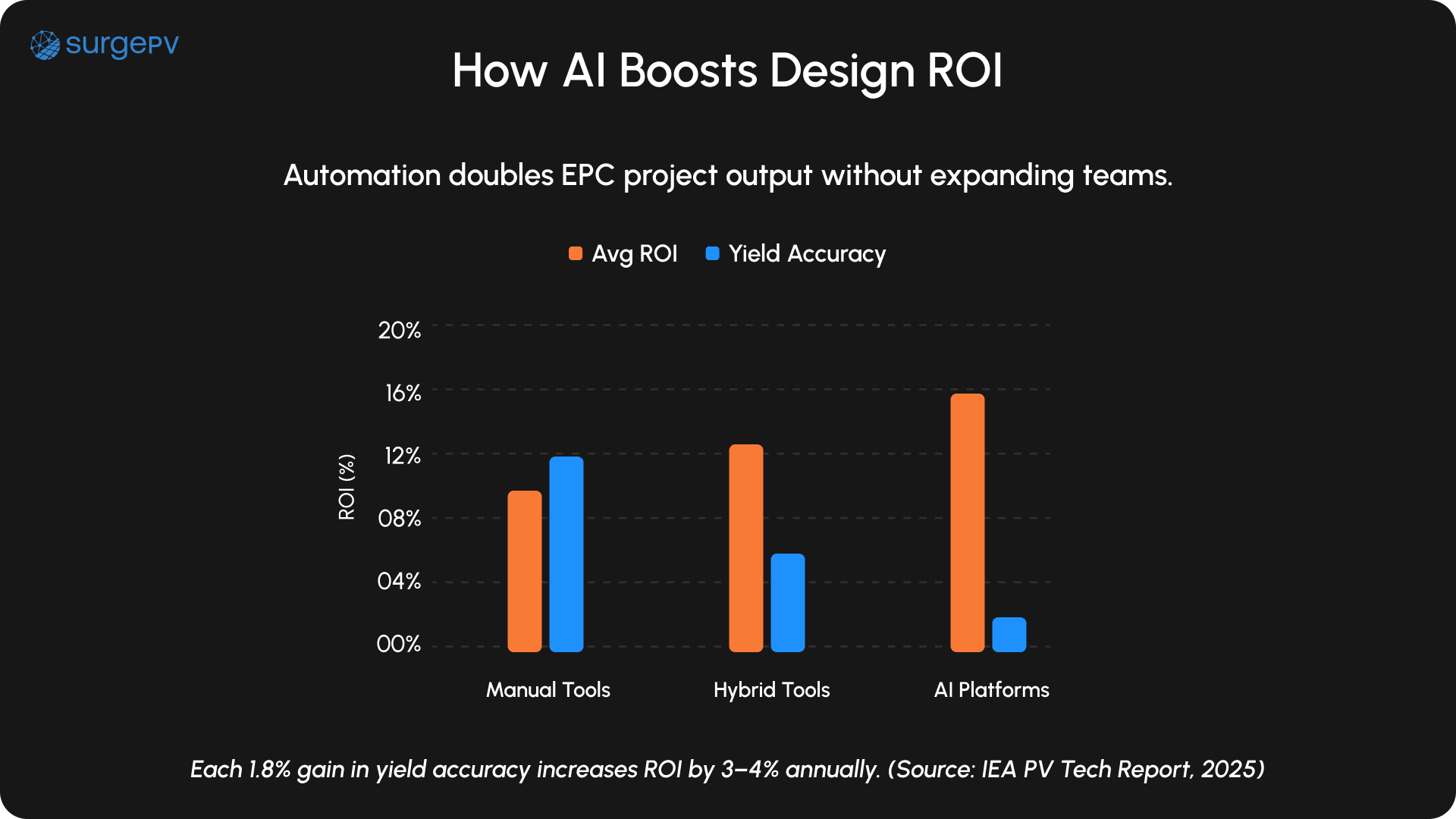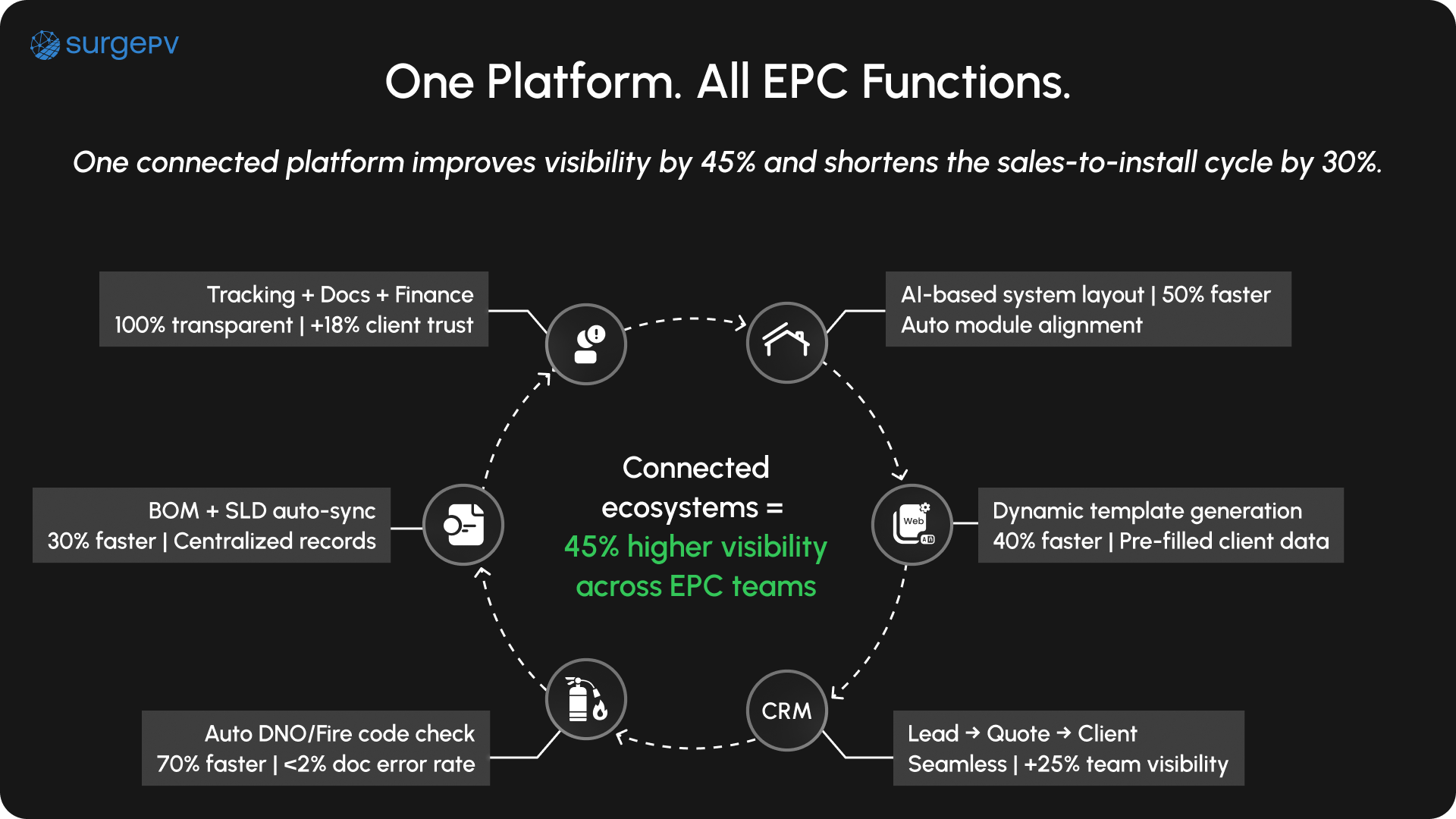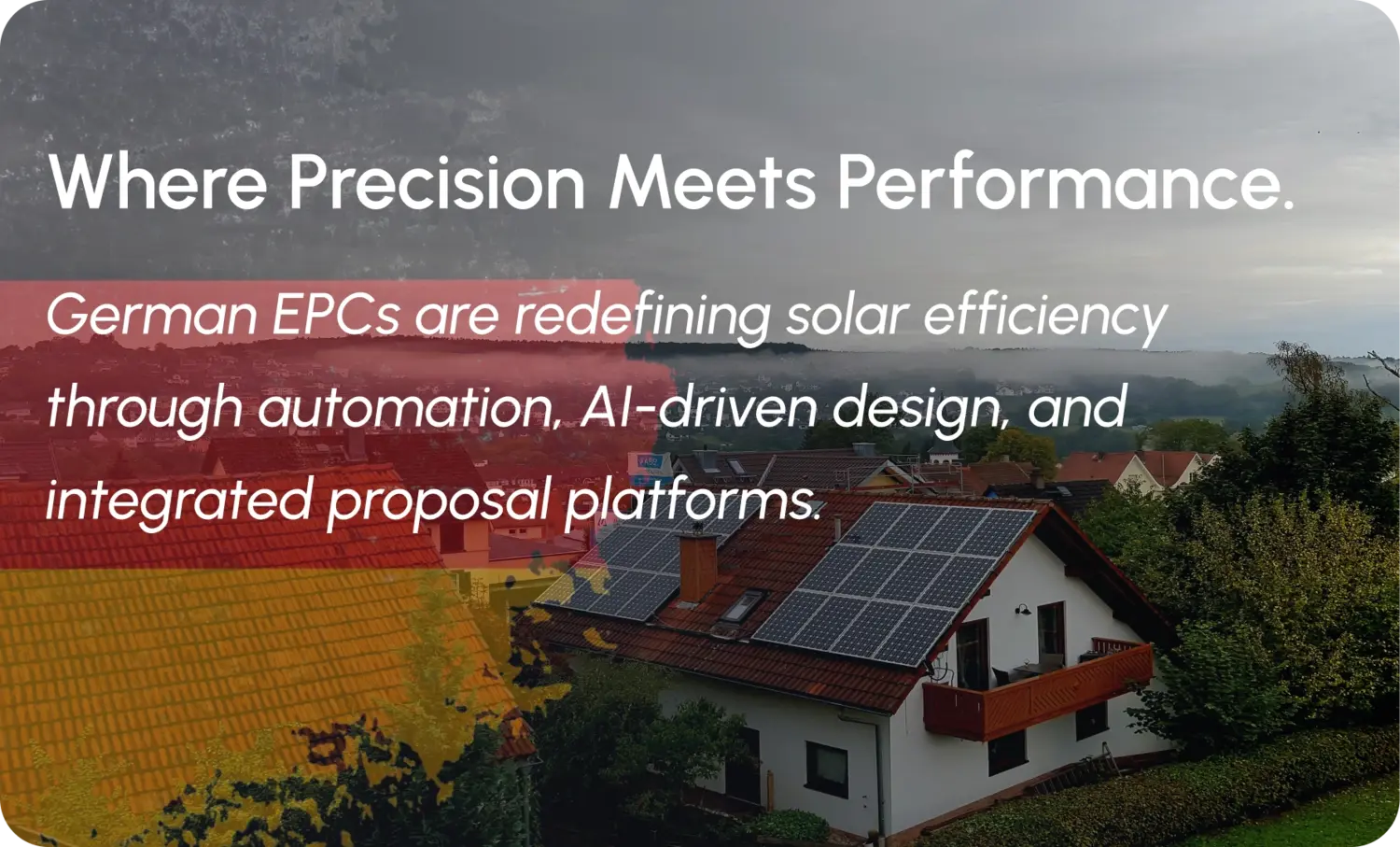Why German EPCs Need Smarter Solar Software in 2025
Germany’s solar market has become a benchmark for Europe—technically advanced, policy-driven, and increasingly competitive. Yet, even as installations surge, many EPCs and installers still struggle with disconnected tools that slow down their design and sales processes. The right solar software helps unify these workflows, connecting technical accuracy with seamless proposal generation and compliance documentation. In 2025, success will hinge not just on who installs the best systems, but on who designs and sells them faster.
The Rise of Digitalization in Germany’s Solar Sector
Germany’s Energiewende movement sparked one of the world’s most rapid transitions to renewable energy. As the solar market matures, digital transformation has become critical to managing scale and complexity. EPCs that once relied on spreadsheets or manual design tools are now shifting to cloud-based platforms that automate design, performance modeling, and financial forecasting.
According to Fraunhofer ISE, digitalization could cut project design times by up to 50%, enabling installers to handle more projects with the same workforce. Smart tools that merge engineering and sales functions are redefining efficiency across the country’s growing solar ecosystem.
“In Germany’s precision-driven solar market, efficiency isn’t an upgrade—it’s survival.”
Challenges with Manual Design and Proposal Processes
Despite strong market momentum, many German EPCs still operate in silos—using one tool for layout, another for shading, and yet another for proposal creation. This fragmentation leads to errors, inconsistent outputs, and slower customer responses.
Key issues EPCs face today:
- Time-consuming data entry across multiple systems
- Inconsistent design documentation and version control
- Lack of integration with proposal and CRM tools
- Difficulty tracking financial and performance assumptions
These gaps not only slow down workflows but also create friction during the approval and financing stages. In a competitive market, every extra step can mean a lost sale or delayed project.
How Connected Platforms Improve Efficiency and Compliance

Modern solar design software addresses these issues through automation and integration. By connecting the design, compliance, and proposal stages within a single ecosystem, EPCs gain visibility, consistency, and control.
Key advantages of connected solar software:
- Centralized project data shared across teams
- Built-in compliance validation for EEG and DIN standards
- Auto-generated performance reports and BOMs
- Seamless export to client-ready proposals
German EPCs adopting integrated solar pv software report shorter project cycles, fewer documentation errors, and improved conversion rates. As grid standards evolve and client expectations rise, the shift toward unified, AI-enabled software isn’t just a technological upgrade—it’s a strategic necessity for staying ahead in 2025.
Key Capabilities to Look for in Solar Design & Proposal Platforms
In a market as advanced as Germany’s, EPCs can’t rely on generic tools. They need solar software that combines engineering-grade accuracy with business intelligence—tools that model complex rooftops, automate shading analysis, calculate tariffs, and create client-ready proposals without switching platforms. The best solutions bridge the technical and commercial sides of every project, empowering teams to move from site survey to signed contract in record time.
“Modern EPCs don’t just design solar systems; they design entire client experiences powered by automation.”
AI-Driven 3D Modeling and Shading Automation

Germany’s diverse building landscape—from historic townhouses to modern industrial roofs—demands high-precision 3D modeling. Platforms equipped with AI-driven design engines automatically detect roof planes, obstructions, and shading zones using aerial or satellite imagery. These tools drastically reduce manual layout time while improving accuracy in tilt, azimuth, and irradiance calculations.
Core capabilities to look for:
- Automated roof detection using AI or LiDAR data
- Real-time shading and irradiance simulation
- Adjustable parameters for roof tilt, obstruction, and module spacing
- One-click 3D visualization for client proposals
By replacing manual CAD adjustments with AI automation, EPCs can produce more accurate and visually appealing designs—often cutting design time by 60% while ensuring consistent compliance with DIN and grid standards.
Built-In Financial Analysis and Tariff Mapping
Design precision means little without financial clarity. The top solar design software integrates tariff-based ROI calculators and cost templates aligned with Germany’s EEG 2025 framework. This ensures installers can present clients with realistic payback periods, savings projections, and self-consumption benefits instantly.
With financial logic built into the design phase, proposals become data-backed narratives that inspire client confidence and simplify financing discussions.
Integrated Proposal Creation and Client Customization
German EPCs spend significant time turning technical outputs into client-facing presentations. Advanced solar proposal software eliminates this friction by merging design visuals, yield data, and ROI models into polished, brand-aligned proposals in minutes.
What to prioritize:
- Auto-generated proposals linked to live design data
- Dynamic templates with EPC branding and localized currency formats
- Instant PDF exports and CRM integration
- Editable tariff and incentive inputs for regional personalization
A unified proposal engine means every quote, simulation, and report comes from the same verified source. It reduces human error, accelerates client response times, and improves conversion rates. For German EPCs handling dozens of quotes per month, this level of automation can be the difference between growth and gridlock.
Modern solar pv software isn’t just a tool—it’s the digital backbone of high-performing EPCs. Platforms that combine 3D design intelligence, automated tariff mapping, and seamless proposal creation set a new standard for accuracy, transparency, and speed in Germany’s competitive solar industry.
Top 5 Solar Software Platforms in Germany (2025 Edition)
Germany’s solar ecosystem has matured into one of the most competitive and technologically advanced in Europe. EPCs now expect solar software that combines engineering-grade precision, regulatory compliance, and sales enablement—all in a single platform. The following tools lead the German market in helping professionals design faster, sell smarter, and manage projects with accuracy and consistency.
“The fastest-growing German EPCs are those that replaced five disconnected tools with one intelligent platform.”
SurgePV – Unified AI Design, Compliance & Proposal Platform
Best for: EPCs and installers seeking an all-in-one solution for AI-driven design, compliance validation, and automated proposals.
Overview:
SurgePV combines the power of artificial intelligence with deep compliance logic tailored for European standards. Its AI roof detection instantly maps roof planes and obstructions, while built-in tariff libraries align financial modeling with Germany’s EEG 2025 regulations. Users can generate detailed DIN-compliant reports, Bills of Materials, and custom-branded proposals in minutes—all from one platform.
Highlights:
- AI-based 3D design with real-time shading simulation
- Built-in tariff and incentive database for Germany
- One-click proposal and BOM exports
- EEG and DIN compliance-ready outputs
- CRM integration for streamlined sales tracking
Why it stands out:
SurgePV eliminates the need for multiple tools, offering an end-to-end workflow that moves seamlessly from design to proposal. German EPCs using SurgePV report up to 65% faster project turnaround times and a notable increase in proposal acceptance rates.
Aurora Solar – Simulation Strength with LIDAR Precision
Best for: Large EPCs and engineering firms needing detailed performance simulations and irradiance modeling.
Overview:
Aurora Solar is widely recognized for its robust performance analytics and LIDAR-supported irradiance modeling. Its advanced algorithms produce highly accurate yield estimates and enable users to compare multiple system configurations before finalizing designs.
Highlights:
- LIDAR-based irradiance and shading models
- Multi-variant system performance simulation
- Integrated ROI and incentive calculators
- Cloud collaboration for multi-user teams
Limitation: Aurora Solar’s feature depth is impressive, but its workflows are primarily designed for the US market, which means limited DIN code integration and localized incentive data for Germany.
PV*Sol – Detailed Energy Simulations for Technical Designers
Best for: Engineers and design specialists focused on precision and in-depth system analysis.
Overview:
PV*Sol is a long-standing favorite among technical users for its simulation depth. The platform’s 3D visualization engine offers complete control over stringing, orientation, and performance calculations. It provides detailed reports on mismatch losses, energy yield, and system efficiency, making it ideal for engineering-driven EPCs.
Highlights:
- 3D simulation with animated shading analysis
- String-level optimization and inverter pairing
- Advanced performance and loss factor reports
- High compatibility with PVSyst data exports
Limitation: While technically superior, PV*Sol’s steep learning curve and standalone structure make it less suited for fast-paced proposal workflows.
Helioscope – Cloud-Based Design for Commercial Projects
Best for: Commercial EPCs looking for speed, simplicity, and collaborative cloud design.
Overview:
Helioscope streamlines project creation with an intuitive browser-based interface. It allows quick layout adjustments, automated irradiance mapping, and simple financial modeling—ideal for EPCs managing several small to mid-scale projects simultaneously.
Highlights:
- Lightweight cloud platform for rapid designs
- Real-time shading and irradiance mapping
- Integrated yield and loss reports
- Easy project sharing and collaboration
Limitation: Helioscope’s simplicity comes at the cost of advanced compliance and tariff modeling capabilities.
OpenSolar – Free-to-Use Platform with Integrated Sales Tools
Best for: Small installers and new EPCs entering the market with limited budgets.
Overview:
OpenSolar provides free access to design and proposal features, making it an excellent entry-level tool for startups. It offers basic 2D and 3D design capabilities, proposal templates, and CRM integration, allowing teams to manage sales pipelines efficiently.
Highlights:
- Free access with unlimited projects
- Built-in proposal customization and e-signature
- Basic shading and irradiance tools
- Online client portal for approvals and revisions
Limitation: OpenSolar’s free model limits advanced simulation accuracy and lacks comprehensive compliance validation for the German market.
Each of these platforms serves a distinct user base. Aurora Solar and PV*Sol lead in simulation precision, Helioscope and OpenSolar excel in accessibility and simplicity, while SurgePV uniquely combines AI-driven design, compliance automation, and proposal integration—making it the most complete platform for modern EPCs in Germany.
Which Solar PV Software Fits German EPCs Best?
Every EPC has different needs—some prioritize compliance, others focus on speed, while a few demand deep simulation accuracy. The right solar software should align with your business model, workforce size, and client expectations. The comparison below highlights how Germany’s top platforms differ across accuracy, automation, proposals, and accessibility.
Feature Comparison (Accuracy, Compliance, 3D, Proposal, Pricing)
This table shows a clear trend: SurgePV leads in both compliance automation and integrated proposal workflows, while PV*Sol remains a top choice for engineers prioritizing depth and technical simulation.
“A strong proposal doesn’t just sell systems—it sells trust, data, and long-term value.”
Best Fit by EPC Size and Use Case
Each platform suits different segments of Germany’s solar industry:
- Residential Installers: SurgePV, OpenSolar
- Commercial EPCs: SurgePV, Helioscope, Aurora Solar
- Engineering-Heavy Firms: PV*Sol, PVcase (optional extension)
For residential and small-scale EPCs, integrated tools that handle both design and proposal generation save hours per project. Larger EPCs often combine detailed simulation tools like PV*Sol with automation platforms like SurgePV for faster client delivery.
Pricing and Accessibility Overview
Transparent pricing and scalability matter as much as accuracy. Here’s a snapshot of how each tool aligns with German EPC budgets:
German EPCs operating in competitive regions like Bavaria and Baden-Württemberg increasingly favor platforms that combine affordability, automation, and multi-team accessibility. SurgePV stands out for offering this balance—scalable pricing with features that suit both small installers and enterprise-level EPCs.
Choosing the right solar pv software is no longer about comparing surface-level features. It’s about selecting the ecosystem that connects technical design with business outcomes—reducing rework, automating proposals, and ensuring every project meets Germany’s compliance and performance expectations.
Evaluating Solar Proposal Workflows for German Installers
A high-quality design is only as powerful as the proposal that communicates it. In Germany’s competitive solar landscape, EPCs need workflows that connect design accuracy with persuasive, client-ready proposals. The most effective solar software tools go beyond technical modeling—they streamline pricing, customization, and documentation to accelerate deal closure while maintaining full compliance under EEG 2025 and DIN standards.
Role of Customization in Client Proposals
No two clients have the same energy priorities. Some prioritize payback speed, while others want to maximize self-consumption or offset carbon emissions. Personalized proposals demonstrate that an EPC understands these differences—and modern solar proposal software makes customization effortless.
What customization should include:
- Dynamic tariff inputs reflecting regional utility rates
- Adjustable consumption profiles (residential vs. commercial)
- Branded templates featuring EPC logos and local language options
- Optional CO₂ offset and savings visualization
Proposals that present financial and environmental impact together improve trust and conversion rates. By tailoring visuals and figures to each client, EPCs build credibility and professionalism without added manual work.
Connecting Design, BOM, and Financial Models
One of the most time-consuming steps in traditional EPC workflows is aligning technical design data with financial modeling and Bills of Materials (BOM). Leading solar design software now automates this connection, ensuring that every proposal reflects the latest layout, pricing, and energy forecast.
Benefits of integrated workflows:
- Automatic BOM generation linked to live system design
- Real-time updates when module quantities or inverters change
- Unified energy yield and financial metrics in proposals
- Streamlined data export to CRM and ERP systems
Visualizing this as a flow: Design → BOM → Tariff/ROI → Proposal → CRM shows how seamless integration eliminates repetitive tasks, reduces quoting errors, and helps EPCs deliver more accurate cost analyses to clients.
“AI won’t replace German solar engineers—it will redefine what they can achieve.”
Measuring Proposal-to-Sale Success Rates
Beyond creating proposals faster, EPCs need visibility into which proposals actually convert. Tracking proposal-to-sale ratios helps measure sales efficiency and identify bottlenecks in the process.
Formula to measure success:
Proposal Conversion Rate (%) = (Number of Proposals Won ÷ Total Proposals Sent) × 100
Integrating proposal tracking within solar pv software allows teams to monitor which design types, pricing structures, or regions deliver the best closure rates. Over time, this data helps EPCs refine pricing strategies, improve response times, and allocate sales resources more effectively.
A strong proposal workflow transforms how EPCs win business. From dynamic customization and BOM automation to conversion analytics, the best solar software platforms empower German installers to present faster, more accurate, and more persuasive offers—turning precision engineering into profitable growth.
Future of Solar Software in Germany
Germany’s solar industry is entering a new era—one defined by automation, AI, and policy-linked intelligence. The next generation of solar software will move beyond design visualization to become intelligent ecosystems that manage compliance, forecasting, and customer engagement. For EPCs, staying competitive will depend on how well they adopt these integrated, data-driven tools.
AI-Driven Policy Validation and Performance Prediction
Artificial intelligence is revolutionizing the way EPCs ensure compliance and forecast solar performance. New platforms will continuously monitor policy changes, tariff updates, and grid requirements under the EEG 2025 framework—alerting users to potential compliance gaps before they even occur.
What to expect from next-gen AI capabilities:
- Real-time validation against evolving EEG and DIN standards
- Predictive yield simulations using live weather and consumption data
- Automated inverter and string optimization powered by machine learning
- Self-adjusting layouts that flag shading, voltage, or wiring conflicts
By merging predictive analytics with compliance logic, future solar pv software will not just help EPCs design systems—it will help them design systems that stay compliant and profitable for decades.
Integration of Dynamic Tariffs and Local Incentives
Energy economics in Germany are becoming more dynamic than ever. Feed-in tariffs, market premiums, and self-consumption incentives are shifting toward real-time and regional models. Future solar design software will integrate these constantly changing tariffs directly into financial simulations.
This level of automation allows EPCs to generate truly personalized proposals—accurate to the client’s region, tariff, and system type—without manual recalculations or policy research.
Collaborative, Cloud-Based EPC Ecosystems

The future of solar software in Germany lies in collaboration. With large EPCs operating across multiple states and partners, cloud ecosystems are replacing isolated workflows. These connected environments allow designers, engineers, and sales teams to work on the same dataset in real time—eliminating version conflicts and improving accountability.
Expert Insight:
“Cloud-based solar ecosystems are transforming how EPCs deliver value. Teams that used to spend days reconciling design versions can now collaborate live, validate compliance instantly, and generate client-ready outputs within hours.” — Julia Neumann, Solar Operations Lead, Berlin
As Germany continues its rapid energy transition, software will evolve from being a design aid to becoming the strategic backbone of every EPC operation. Those who embrace AI, policy automation, and connected workflows will define the future of solar success in Europe’s most advanced renewable market.
FAQs
What is the best solar software for German EPCs in 2025?
The best solar software for German EPCs is one that connects design, compliance, and proposals in a single platform. SurgePV leads the market with AI-driven design automation, built-in EEG 2025 tariff mapping, and DIN-compliant documentation—making it ideal for both residential and commercial installers.
How does solar design software help meet German regulations?
Modern solar design software automates regulatory compliance by validating system parameters against local EEG and DIN standards. It checks voltage rise, inverter configurations, and export limits while generating pre-formatted documentation for grid connection and financing submissions.
Which software offers the most accurate energy yield simulation?
PV*Sol and SurgePV are known for high-accuracy simulations. PV*Sol provides deep technical control and visualization, while SurgePV combines LiDAR, PVGIS, and AI-based irradiance models to achieve precision within ±1.5%, making it reliable for proposal-grade projections.
Can solar software generate proposals and financial reports automatically?
Yes. Tools like SurgePV and Aurora Solar integrate financial models, Bills of Materials (BOMs), and branded proposals directly into the design process. This automation reduces manual quoting time by over 60% and ensures every proposal reflects the latest layout and tariff data.
What is the future of solar pv software in Germany?
The future lies in AI-based policy automation, dynamic tariff integration, and collaborative EPC ecosystems. Platforms will increasingly merge live policy data from BMWK and EEG with predictive yield modeling—giving EPCs real-time accuracy, faster compliance, and better customer engagement.


